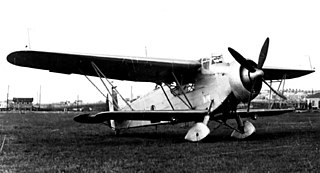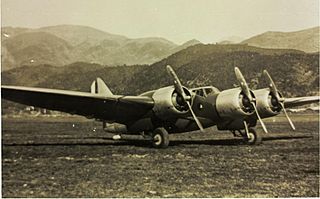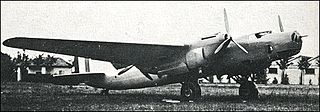| P.3 | |
|---|---|
 | |
| Role | Night bomber |
| Manufacturer | Piaggio |
| Designer | Giovanni Pegna |
| First flight | 1923 |
| Primary user | Regia Aeronautica |
The Piaggio P.3 was an Italian night bomber prototype built by Piaggio in 1923.
| P.3 | |
|---|---|
 | |
| Role | Night bomber |
| Manufacturer | Piaggio |
| Designer | Giovanni Pegna |
| First flight | 1923 |
| Primary user | Regia Aeronautica |
The Piaggio P.3 was an Italian night bomber prototype built by Piaggio in 1923.
Designed by Ing Giovanni Pegna, the P.3 was a four-engine, two-bay biplane with wings of unequal span, the lower wing being greater in span than the upper. Its four 149-kilowatt (200-horsepower) S.P.A. 6A engines were mounted in tandem pairs on the lower wing, with each engine driving one of four propellers, two mounted in a tractor and two in a pusher configuration. The P.3's tail was of biplane configuration with three rudders mounted between the two planes. The crew of four consisted of a pilot, co-pilot, nose gunner, and rear gunner; the pilot and co-pilot sat side by side in a cockpit just ahead of the wings, the nose gunner manned a machine gun mounted in a cockpit in front of them, and the rear gunner manned two machine guns, one in an amidships cockpit behind the pilots and another mounted in a ventral tunnel for defense against attacks from below.
The P.3 made its first flight in 1923, and Piaggio later installed two 306-kilowatt (410-horsepower) Fiat A.20V engines on the aircraft. However, the Regia Aeronautica (Italian Royal Air Force) did not place a production order for the P.3.
| | This aircraft article is missing some (or all) of its specifications. If you have a source, you can help Wikipedia by adding them. |
General characteristics
Performance
Armament

The Savoia-Marchetti SM.81 Pipistrello was the first three-engine bomber/transport aircraft serving in the Italian Regia Aeronautica. When it appeared in 1935, it represented a real step ahead in Italian military aviation: it was fast, well armed and had a long range. It proved effective during the war with Ethiopia and the Spanish Civil War. Despite being too slow to remain competitive as a bomber in the later years of World War II, it was one of the most flexible, reliable and important aircraft of the Regia Aeronautica from 1935 to 1944, and adapted to second-line duties in a wide range of tasks.

The Breda Ba.88 Lince ("Lynx") was a ground-attack aircraft used by the Italian Regia Aeronautica during World War II. Its streamlined design and retractable undercarriage were advanced for the time, and after its debut in 1937 the aircraft established several world speed records. However, when military equipment was installed on production examples, problems of instability developed and the aeroplane's general performance deteriorated. Eventually its operational career was cut short, and the remaining Ba.88 airframes were used as fixed installations on airfields to mislead enemy reconnaissance. It represented, perhaps, the most remarkable failure of any operational aircraft to see service in World War II.

The Savoia-Marchetti SM.91 was a two-seat, twin-engined, Italian heavy fighter prototype, designed to compete in a 1942 revision to a long-range fighter-bomber contract offered by the Regia Aeronautica to Italian aircraft companies in 1938. The original 1938 specification yielded the Savoia-Marchetti SM.88, which the SM.91 was largely based on.

The Savoia-Marchetti SM.78 was an Italian bomber/reconnaissance biplane flying boat of the early 1930s.

The Caproni Ca.101 was a three-engine Italian airliner which later saw military use as a transport and bomber. It was designed in 1927 and first flown in 1928.

The Breda Ba.201 was an Italian dive bomber designed during World War II, that never entered production.

The Piaggio P.119 was an Italian experimental fighter of World War II. It had a relatively novel layout, with a "buried" radial engine mounted mid-fuselage. Only a single prototype was built before the Armistice between Italy and the allied armed forces, which ended the project.

The IMAM Ro.30 was a 1930s Italian observation biplane designed and built by Industrie Meccaniche e Aeronautiche Meridionali. It was only built in limited numbers before being replaced by the Ro.37.

The Caproni Ca.70 was a two-seat night fighter and ground attack biplane produced in Italy in 1925. It was the only Italian aircraft designed from the outset as a night fighter.

The Caproni Ca.71, originally Ca.70L, was a two-seat biplane night fighter produced in Italy in 1927. It was derived from the Caproni Ca.70 of 1925.

The Caproni CH.1 was a single-seat biplane fighter, a single example of which was produced as a prototype in Italy in 1935.

The Caproni Ca.331 Raffica was an Italian aircraft built by Caproni in the early 1940s as a tactical reconnaissance aircraft/light bomber and also as a night fighter.

The Piaggio P.16 was an Italian heavy bomber designed and built by Piaggio for the Regia Aeronautica.

The Piaggio P.50 was an Italian prototype heavy bomber designed and built by Piaggio for the Regia Aeronautica.
The Gabardini G.8 was an Italian single-seat aircraft produced in both fighter and trainer versions by Gabardini in 1923.

The Macchi M.70, was an Italian light biplane of the late 1920s built by Macchi.

The Vickers F.B.25 was a British two-seat night fighter prototype of World War I designed to attack enemy airships. Completed in 1917, it failed in its official flight tests that year and no order for production resulted.
The Caproni Ca.66 was an Italian night bomber designed to reequip the post-World War I Italian Air Force. Only two examples of the four-engined biplane were built.
The Henri Farman HF.35 was a large 3-seat biplane designed and built in France by Henri Farman during 1915.
The Caproni Ca.66 and Caproni Ca.67 were Italian night bomber aircraft designed to re-equip the post-World War I Regia Aeronautica.